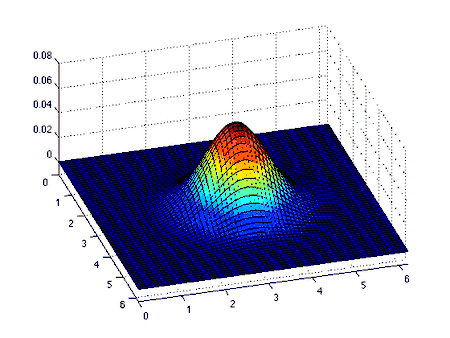Burgers' equation
Burgers' equation or Bateman–Burgers equation is a fundamental partial differential equation occurring in various areas of applied mathematics, such as fluid mechanics,[1] nonlinear acoustics,[2] gas dynamics, and traffic flow. The equation was first introduced by Harry Bateman in 1915[3][4] and later studied by Johannes Martinus Burgers in 1948.[5]
For a given field and diffusion coefficient (or kinematic viscosity, as in the original fluid mechanical context) , the general form of Burgers' equation (also known as viscous Burgers' equation) in one space dimension is the dissipative system:
When the diffusion term is absent (i.e. ), Burgers' equation becomes the inviscid Burgers' equation:
which is a prototype for conservation equations that can develop discontinuities (shock waves). The previous equation is the advective form of the Burgers' equation. The conservative form is found to be more useful in numerical integration
Explanation of Terms
There are 4 terms in Burgers' equation: and . In a system consisting of a moving viscous fluid with one spatial () and one temporal () dimension, e.g. a thin ideal pipe with fluid running through it, Burgers' equation describes the speed of the fluid at each location along the pipe as time progresses. The terms of the equation represent the following quantities:[6]
- : spatial coordinate
- : temporal coordinate
- : speed of fluid at the indicated spatial and temporal coordinates
- : viscosity of fluid
The viscosity is a constant physical property of the fluid, and the other terms represent the dynamics contingent on that viscosity.
Inviscid Burgers' equation

The inviscid Burgers' equation is a conservation equation, more generally a first order quasilinear hyperbolic equation. The solution to the equation and along with the initial condition
can be constructed by the method of characteristics. The characteristic equations are
Integration of the second equation tells us that is constant along the characteristic and integration of the first equation shows that the characteristics are straight lines, i.e.,
where is the point (or parameter) on the x-axis (t = 0) of the x-t plane from which the characteristic curve is drawn. Since at the point, the velocity is known from the initial condition and the fact that this value is unchanged as we move along the characteristic emanating from that point, we write on that characteristic. Therefore, the trajectory of that characteristic is
Thus, the solution is given by
This is an implicit relation that determines the solution of the inviscid Burgers' equation provided characteristics don't intersect. If the characteristics do intersect, then a classical solution to the PDE does not exist and leads to the formation of a shock wave. In fact, the breaking time before a shock wave can be formed is given by
Inviscid Burgers' equation for linear initial condition
Subrahmanyan Chandrasekhar provided the explicit solution in 1943 when the initial condition is linear, i.e., , where a and b are constants.[7] The explicit solution is
This solution is also the complete integral of the inviscid Burgers' equation because it contains as many arbitrary constants as the number of independent variables appearing in the equation.[8] Explicit solutions for other relevant initial conditions are, in general, not known.
Viscous Burgers' equation

The viscous Burgers' equation can be converted to a linear equation by the Cole–Hopf transformation [9][10]
which turns it into the equation
which can be integrated with respect to to obtain
where is a function that depends on boundary conditions. If identically (e.g. if the problem is to be solved on a periodic domain), then we get the diffusion equation
The diffusion equation can be solved, and the Cole-Hopf transformation inverted, to obtain the solution to the Burgers' equation:
Other forms
Generalized Burgers' equation
The generalized Burgers' equation extends the quasilinear convective to more generalized form, i.e.,
where is any arbitrary function of u. The inviscid equation is still a quasilinear hyperbolic equation for and its solution can be constructed using method of characteristics as before.[11]
Stochastic Burgers' equation
Added space-time noise forms a stochastic Burgers' equation[12]
This stochastic PDE is the one-dimensional version of Kardar–Parisi–Zhang equation in a field upon substituting .
References
- It relates to the Navier–Stokes momentum equation with the pressure term removed Burgers Equation (PDF): here the variable is the flow speed y=u
- It arises from Westervelt equation with an assumption of strictly forward propagating waves and the use of a coordinate transformation to a retarded time frame: here the variable is the pressure
- Bateman, H. (1915). Some recent researches on the motion of fluids. Monthly Weather Review, 43(4), 163-170.
- Whitham, G. B. (2011). Linear and nonlinear waves (Vol. 42). John Wiley & Sons.
- Burgers, J. M. (1948). A mathematical model illustrating the theory of turbulence. In Advances in applied mechanics (Vol. 1, pp. 171-199). Elsevier.
- Cameron, Maria. "NOTES ON BURGERS'S EQUATION" (PDF).
- Chandrasekhar, S. (1943). "On the decay of plane shock waves" (No. 423). Ballistic Research Laboratories. Cite journal requires
|journal=(help) - Forsyth, A. R. (1903). A Treatise on Differential Equations. London: Macmillan.
- Cole, Julian (1951). "On a quasi-linear parabolic equation occurring in aerodynamics". Quarterly of Applied Mathematics. 9 (3): 225–236. JSTOR 43633894.
- Eberhard Hopf (September 1950). "The partial differential equationy ut + uux = μuxx". Communications on Pure and Applied Mathematics. 3 (3): 201–230. doi:10.1002/cpa.3160030302. hdl:10338.dmlcz/102083.
- Courant, R., & Hilbert, D. Methods of Mathematical Physics. Vol. II.
- Wang, W.; Roberts, A. J. (2015). "Diffusion Approximation for Self-similarity of Stochastic Advection in Burgers' Equation". Communications in Mathematical Physics. 333: 1287–1316. arXiv:1203.0463. doi:10.1007/s00220-014-2117-7.
External links
- Burgers' Equation at EqWorld: The World of Mathematical Equations.
- Burgers' Equation at NEQwiki, the nonlinear equations encyclopedia.
- Burgers' Equation Wolfram|Alpha search results.
